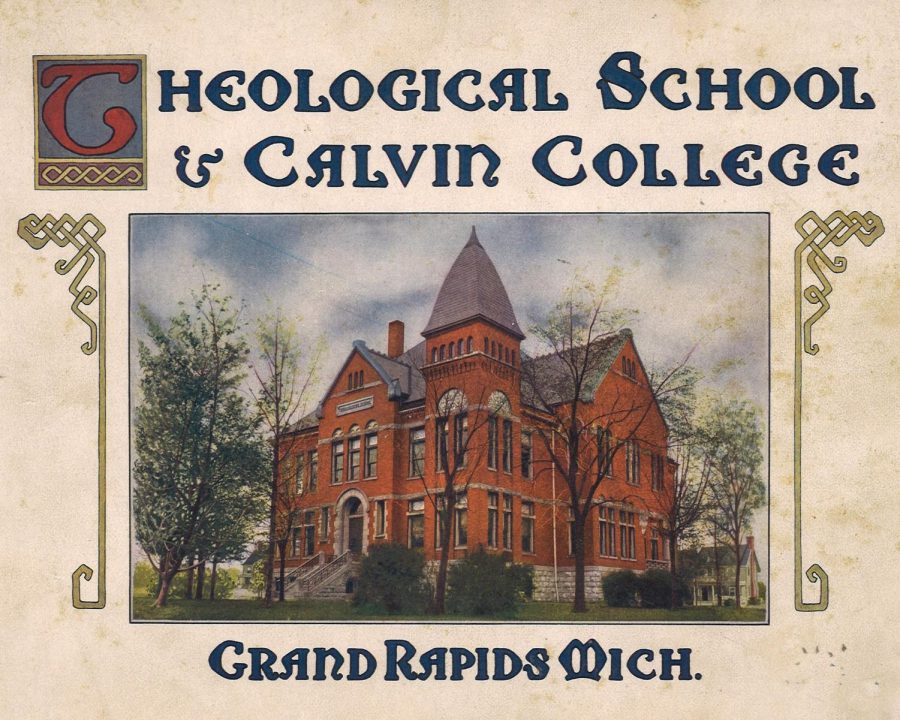“Sibling institutions”: Understanding the relationship between Calvin University and Calvin Theological Seminary
Image courtesy Heritage Hall Archives
Cover from a 1910 souvenir booklet for the Theological School and Calvin College, depicting the main building.
Calvin University and Calvin Theological Seminary have long been partners in education, sharing both spaces and faculty. As the institutions have evolved over time, they have increasingly separated; however, the addition of new graduate programs is an unexplored avenue for closer future partnership.
History
Calvin University and Calvin Theological Seminary — now separate entities — began as a single institution, the Theological School, which was founded in 1876 to train pastors. In 1884, the Theological School also began to admit future teachers. The institution separated around 1906, when John Calvin Junior College was recognized as distinct from the theological seminary.
Over the next 25 years, John Calvin Junior College developed into Calvin College — a four-year college focused on students entering the professional world — while Calvin Theological Seminary grew into a graduate school focused on pastoral training. The two institutions shared a board of trustees until 1991, when the Synod of the Christian Reformed Church approved a plan to give each institution its own board.
According to then-President Anthony Diekema, the need for a separate board to consider the unique challenges of each school was a motivating factor in the split.
“[B]oth schools need close attention to their specific needs and purposes,” said Diekema in an interview published in the Sept. 1991 edition of “Spark” magazine. “It became increasingly unwieldy to have one board of trustees addressing the issues and concerns of two different institutions.” Even today, however, the institutions share “the same history, the same mission and vision of serving the world, and the Reformed perspective,” said Annie Mas-Smith, director of communications and enrollment management for Calvin Theological Seminary.
After the separation, Calvin College (now University) and Calvin Theological Seminary remained in relationship. Today, they share a Campus Safety team as well as facilities such as the Hekman Library, the H. Henry Meeter Center for Calvin Studies and the Calvin Institute of Christian Worship.
“It just made more sense to divide them up. But it’s not a division of hostility. It’s a division of, ‘this is just more practical,’” said Karin Maag, who has been director of the Meeter Center since 1997.
Some practical concerns may have related to differences between the two institutions’ student bodies. The university was — and is — much larger; currently, the university has about 3,230 students, while the seminary has 239.
Seminary students also tend to be older and in a different stage of life than Calvin’s undergraduates, which affects how student life plays out, according to Anne Harrison, theological librarian at the Hekman Library.
“A lot of people at that time might have families, and a lot of times, the seminary will try to get the families involved as well,” said Harrison, who mentioned picnics and dinners as common social events at the seminary.
Seminary work is also more specialized and happens year-round. Even when undergraduate students went home during COVID-19, some seminary students remained in their seminary housing and continued to work on research, according to Maag.
Present
Shared resources — such as the Hekman Library and the Meeter Center — are governed by a board of representatives from both the university and the seminary and decisions about budgeting and hiring are made jointly. Harrison, who started as theological librarian early in 2020, said she had to be interviewed and approved by both institutions.
According to Harrison, balancing the needs of two different student bodies can create challenges, but the library still strives to be a space for both university and seminary students.
“I think there’s always this goal and this longing to make sure that we’re serving both equally,” said Harrison.
In addition to sharing spaces, professors from departments such as religion, history and education sometimes teach at both Calvin University and Calvin Theological Seminary, depending on the needs of the institutions. Maag started her career at Calvin as a history professor at the university, but currently teaches as an adjunct at the seminary. The switch happened around 2017, when the seminary asked Maag to teach classes on her specialty of Reformation studies.
Maag continues to teach for the Calvin Academy for Lifelong Learning — a university program for adult learners — and could see herself returning to the university as the needs and opportunities at each institution shift.
Future
This fall the seminary is introducing a Master’s of Arts in Clinical Mental Health Counseling. According to Mas-Smith, this could lead to increased faculty overlap as well as students in psychology-related fields choosing the university for their undergraduate degree, then attending seminary for graduate school.
Representatives from both institutions are interested in maintaining and strengthening their historical ties in the area of academics, though there are no concrete plans on what this would look like.
“I think we could both benefit from our combined efforts in terms of the grad[uate] programs, but we haven’t really delved into that yet,” said Renee De Vries, graduate studies coordinator for Calvin University.






